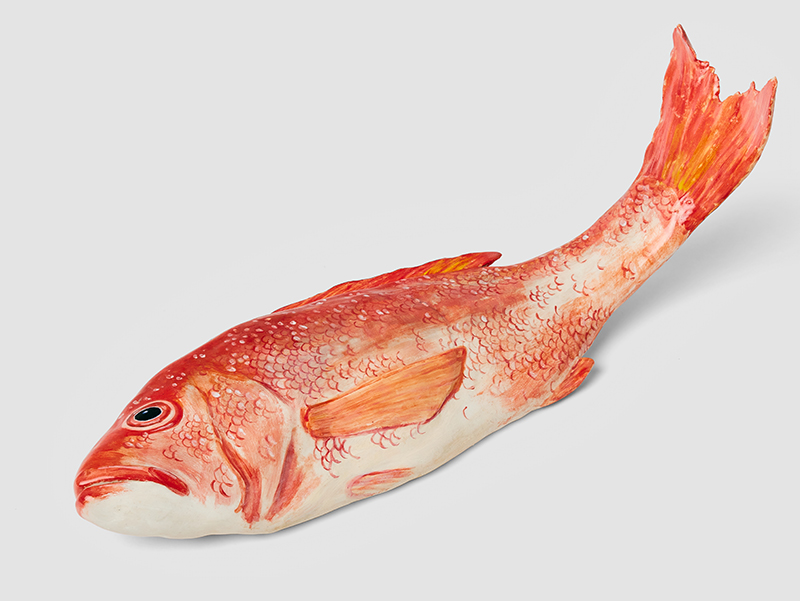Object of the Month: "Red Snapper" (2023) by Stephanie H. Shih
By Bowdoin College Museum of Art
Stephanie H. Shih, Red Snapper, 2023, painted ceramic. Bowdoin College Museum of Art, Brunswick, Maine, Museum Purchase. Courtesy of the artist and Berggruen Gallery, San Francisco. Photo: Robert Bredvad
I first encountered Stephanie Shih’s work on a museum visit for “Asian America & Empire”, a class taught by Belinda Kong, Connie Chiang, and Nancy Riley, professors and co-curators of the exhibition Without Apology: Asian American Selves, Memories, Futures (December 14, 2023–June 2, 2024) at the Bowdoin College Museum of Art (BCMA). Shih’s ceramic sculptures of food immediately stood out to me. At first glance, I was struck with a sense of nostalgia and comfort. They reminded me of grocery store items I grew up seeing at home in Queens, New York. These were things I did not expect to see in a museum setting. This made me wonder—why were they on display at the BCMA?
Stephanie Shih, born in 1986, is a Taiwanese American ceramicist who explores the Asian American diasporic experience through food and other culturally significant symbols. While working as a copywriter and creative director, she picked up ceramics as a form of therapy for her chronic back pain. In the process, she was drawn to making porcelain dumplings, pulling from her early childhood memories of folding dumpling wrappers with her family. Inspired by the nostalgic feelings her dumplings invoked in herself, she shared her ceramic pieces with her growing social media following and quickly received immense support. Many of her followers expressed deep personal connections with their own cultural foods. Thus, she began surveying her followers for the grocery items that most represent their Asian heritage, sparking her next project: ceramics pieces resembling grocery store items rooted in shared diasporic experience. Red Snapper is one of four grocery items the BCMA showcased.
Interestingly, while much of her crowdsourced items, like jasmine rice and soy sauce, are more recognizably Asian, others, like Spam and Ferrero Rocher, reflect a hybrid cultural identity. Shih was interested in blurring these culinary lines, aiming to represent the cross-cultural diasporic experience. Specifically, her work explores how grocery items are repurposed and reinterpreted in immigrant households. Shih uses food as a symbol for lived diasporic experiences. “Many people describe immigrating or being the child of immigrants as being split between two worlds”, she explains. “But I find that view to be somewhat limiting. Borders, whether political or cultural, are a social construct, and I don't think it's possible to draw a line down the middle of your lived experience. Rather, I like to think that immigrants and their children exist in a space that blurs those very lines – and that's what I'm most interested in making art about.”[1]
Shih’s work invites reflection on the status of Asian food in the Western consciousness. For example, in the United States during the period affected by the Chinese Exclusion Act (1882–1943), Chinese food came to be associated with xenophobic tensions. Labor unions targeted Chinese restaurants and business owners, portraying them as an economic threat. Harmful stereotypes were perpetuated about the cleanliness and healthiness of Asian cuisine, and these stereotypes furthered the exclusion of Asian people from Western society. In recent years, the aesthetic of Asian food has drastically transformed from one of disdain to inspiration. Even as Asian foods and ingredients have entered mainstream media, they are consumed with a sense of exoticism. While recipes and trends have shared and reinterpreted the use of Asian ingredients across the globe, these Asian household staples have been stripped of their cultural significance. By choosing grocery items as her subject matter, Shih reclaims and recontextualizes Asian food from the Western consciousness. For Shih and other immigrants, food is a material link to family and heritage serves as a language of love, memory, and resilience–a vessel to relay and preserve culture.
As Belinda Kong observes, “This is the kind of art that influences the museum space more than the museum space influences the art.” Shih’s work pushes the boundaries of what and who belongs in the fine arts space. For some museum-goers, her work is instantly recognizable and comforting. For others, it raises unfamiliar questions: Why is this here? What does it mean? In that subtle tension, Shih creates an opening for critical engagement and cross-cultural dialogue. Shih’s work is truly reparative, not only seeking to incite change but to shift the museum space away from its usual Eurocentric context.
Edwin Kim ’27Student Communications & Shop Assistant
[1] Atkins, Olivia. “Ceramic Artist Stephanie H. Shih Recreates Food Products in Clay to Explore Cultural Identity | Creative Boom.” Creative Boom (January 9, 2023). Accessed August 2025. www.creativeboom.com/inspiration/stephanie-h-shih/